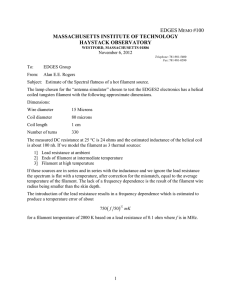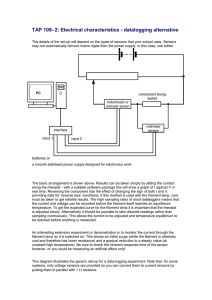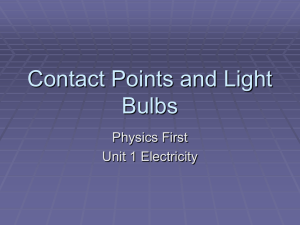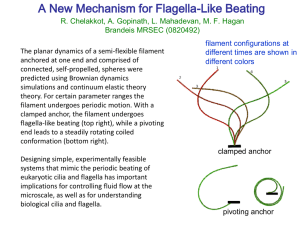techniques to extend the service life of high power vacuum tubes
advertisement
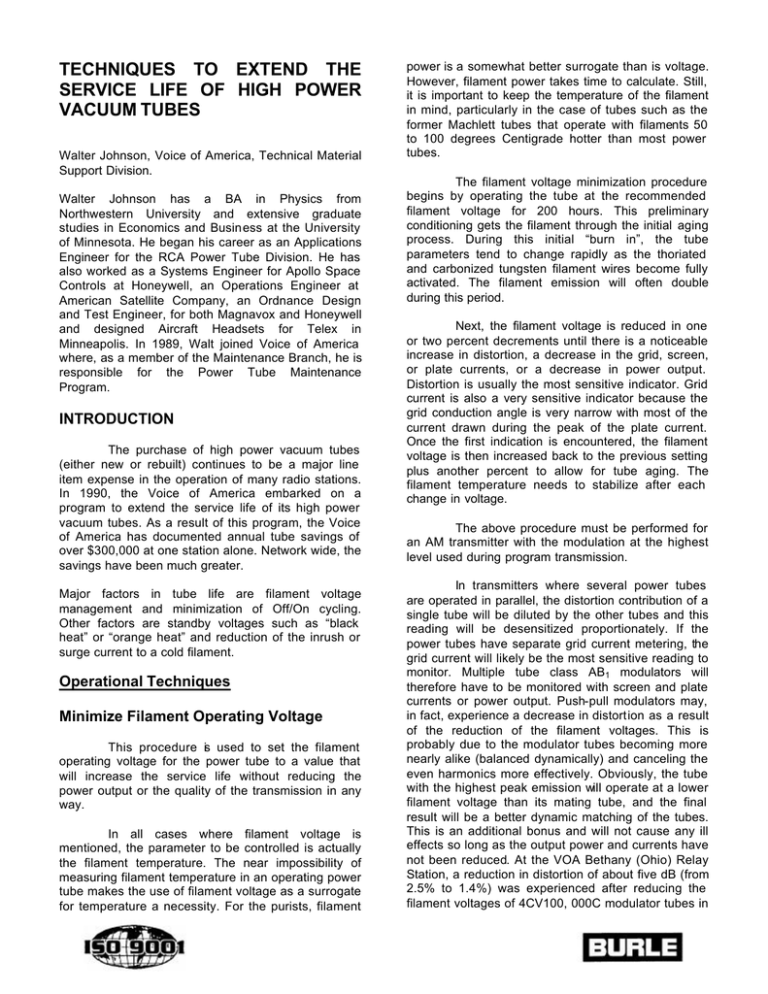
TECHNIQUES TO EXTEND THE SERVICE LIFE OF HIGH POWER VACUUM TUBES Walter Johnson, Voice of America, Technical Material Support Division. Walter Johnson has a BA in Physics from Northwestern University and extensive graduate studies in Economics and Business at the University of Minnesota. He began his career as an Applications Engineer for the RCA Power Tube Division. He has also worked as a Systems Engineer for Apollo Space Controls at Honeywell, an Operations Engineer at American Satellite Company, an Ordnance Design and Test Engineer, for both Magnavox and Honeywell and designed Aircraft Headsets for Telex in Minneapolis. In 1989, Walt joined Voice of America where, as a member of the Maintenance Branch, he is responsible for the Power Tube Maintenance Program. INTRODUCTION The purchase of high power vacuum tubes (either new or rebuilt) continues to be a major line item expense in the operation of many radio stations. In 1990, the Voice of America embarked on a program to extend the service life of its high power vacuum tubes. As a result of this program, the Voice of America has documented annual tube savings of over $300,000 at one station alone. Network wide, the savings have been much greater. Major factors in tube life are filament voltage management and minimization of Off/On cycling. Other factors are standby voltages such as “black heat” or “orange heat” and reduction of the inrush or surge current to a cold filament. Operational Techniques Minimize Filament Operating Voltage This procedure is used to set the filament operating voltage for the power tube to a value that will increase the service life without reducing the power output or the quality of the transmission in any way. In all cases where filament voltage is mentioned, the parameter to be controlled is actually the filament temperature. The near impossibility of measuring filament temperature in an operating power tube makes the use of filament voltage as a surrogate for temperature a necessity. For the purists, filament power is a somewhat better surrogate than is voltage. However, filament power takes time to calculate. Still, it is important to keep the temperature of the filament in mind, particularly in the case of tubes such as the former Machlett tubes that operate with filaments 50 to 100 degrees Centigrade hotter than most power tubes. The filament voltage minimization procedure begins by operating the tube at the recommended filament voltage for 200 hours. This preliminary conditioning gets the filament through the initial aging process. During this initial “burn in”, the tube parameters tend to change rapidly as the thoriated and carbonized tungsten filament wires become fully activated. The filament emission will often double during this period. Next, the filament voltage is reduced in one or two percent decrements until there is a noticeable increase in distortion, a decrease in the grid, screen, or plate currents, or a decrease in power output. Distortion is usually the most sensitive indicator. Grid current is also a very sensitive indicator because the grid conduction angle is very narrow with most of the current drawn during the peak of the plate current. Once the first indication is encountered, the filament voltage is then increased back to the previous setting plus another percent to allow for tube aging. The filament temperature needs to stabilize after each change in voltage. The above procedure must be performed for an AM transmitter with the modulation at the highest level used during program transmission. In transmitters where several power tubes are operated in parallel, the distortion contribution of a single tube will be diluted by the other tubes and this reading will be desensitized proportionately. If the power tubes have separate grid current metering, the grid current will likely be the most sensitive reading to monitor. Multiple tube class AB1 modulators will therefore have to be monitored with screen and plate currents or power output. Push-pull modulators may, in fact, experience a decrease in distortion as a result of the reduction of the filament voltages. This is probably due to the modulator tubes becoming more nearly alike (balanced dynamically) and canceling the even harmonics more effectively. Obviously, the tube with the highest peak emission will operate at a lower filament voltage than its mating tube, and the final result will be a better dynamic matching of the tubes. This is an additional bonus and will not cause any ill effects so long as the output power and currents have not been reduced. At the VOA Bethany (Ohio) Relay Station, a reduction in distortion of about five dB (from 2.5% to 1.4%) was experienced after reducing the filament voltages of 4CV100, 000C modulator tubes in the Collins 821A -1 transmitters. A close watch should be kept on the tubes for the next few days to check for changes in the above operating parameters. The procedure should be repeated about once a month or if any adverse changes do occur. A dramatic increase in the emissive life of the filaments can be realized if the tube has enough excess emission to permit a reduction of five percent or more in the filament voltage. For each three percent reduction in filament voltage, the emissive life of the filament will about double. A five percent filament voltage reduction will therefore more than triple the emissive life. cube of the inrush current. By limiting this inrush current or, by preferably eliminating it, the life of the power tube filament can be lengthened several times. The Egyptian Ministry of Information operates a two megawatt transmitter in the medium wave band. This Doherty transmitter uses four tubes, two carrier tubes, and two peak tubes working through a combiner. Even though the transmitter was operating more than 22 hours per day, the filaments were turned off and back on every night. The very expensive tubes (about $100,000 each) were lasting only 5,500 hours, and a stock of 10 spares was expected to last 18 months for the four sockets. After leaving the filaments on continuously and rotating the spare tubes annually, the station has yet to have a tube failure after seven years. OFF/ON FILAMENT CYCLING When a cold filament is turned on, damage is caused by two effects: (1) The current inrush into a cold filament can be up to 10 times the operating current if the filament supply is of very low impedance; (2) Grain reorientation occurs at about 600 to 700 degrees centigrade; this is called the Miller-Larson Effect. The grain reorientation will result in a momentary plastic state that can cause the wire to grow in length and therefore become thinner. To illustrate the first effect, one can use an ordinary 60 watt light bulb. The light bulb should operate at 0.5 amps at 120 volts. This translates to a hot resistance of 240 Ohms. An Ohmmeter reading of a room temperature 60 watt light bulb will be less than 20 Ohms or, a hot to cold ratio of greater than 12. Power tube filaments will have about a ten to one hot to cold ratio because they operate at a lower temperature than light bulbs. The second effect is aggravated by variations in the cross sectional area of the filament wires along their length. This will cause “hot spots” in the thinner cross sections due to the greater current densities. The higher temperatures at the hot spots cause increased growth during the warm-up through the 600 degree Centigrade temperature when they have a higher current density than the rest of the wire, and a much higher power dissipation per unit length due to also having a higher resistance. Each time the filament is turned on, the wire becomes thinner until the hot spot temperature gets into a runaway condition. During the runaway, the filament temperature reaches the melting point during the turn on surge, and the light bulb (or filament) produces the familiar flash bulb effect that signals its demise. Light bulbs nearly always burn out during the turn on inrush surge. Each Off/On cycle removes several hours of life from the light bulb (or filament) and this trauma is approximately proportional to the In Greenville, North Carolina, VOA has four 500 kW transmitters with vapor cooled tubes. The transmitters are used for 12 to 15 hours per day. Initially, the filaments were turned off and on two or three times per day during gaps in the schedules. Three years ago, VOA began leaving the filaments on at all times except for major maintenance. As a result, the expenditures for tubes for these transmitters has dropped from about $420,000 per year to under $100,000. This was done at a cost of $15,000 per year in added electrical power cost. For every extra dollar spent on added filament power, we had a return of more than 20 dollars in reduced tube costs eat your heart out Wall Street! Calculations for both of the above situations indicate that each Off/On cycle of the filament was reducing the life expectancies by over 75 hours. An unexpected result was that it appeared to be independent of the filament construction - straight wire, hairpin, and mesh filaments all benefited nearly equally by leaving the filaments on continuously. The mesh filament was expected to suffer more from Off/On cycling because of flexing of the many welds. Also, the mesh filament structure will grow in overall diameter as the wires lengthen. It is constructed in a manner similar to a Chinese finger trap which changes overall diameter as the axial length is changed. This mesh filament construction causes an additional failure mode because the overall mesh diameter can grow enough to cause a grid-to-filament short before a wire breaks. In many large power tetrodes, the grid to filament spacing is less than two percent of the overall filament diameter and the diameter tends to grow more at the bottom of the filament due to gravity. Measuring Mu to Predict Filament-Grid Shorts As the filament wires lengthen and our Chinese finger trap mesh filament grows in overall diameter, this change in the tube geometry will cause an increase in the Mu or amplification factor. This is aggravated by gravity which causes added growth at the bottom of the filament. Radio station HCJB of Ecuador successfully predicted filament to grid shorts by periodically measuring the amplification factor. A gradual increase in Mu will be noticed as the tube ages. As the rate of change increases (after at least 50,000 hours, it is hoped) to five or ten times the earliest rate, the short condition is imminent and the tube should be changed to prevent lost air time. Black Heat Discussions with tube designers have suggested that the “Black Heat” or stand by filament voltage should be between 25 and 40 percent of the rated filament voltage. This range will produce a temperature high enough to keep the filament above 600 degrees centigrade area where the Miller-Larson Effect occurs and sometimes low enough so that forced cooling is not required during stand-by. Operating histories of several “Black Heat” installations indicate that the trauma of raising the filament voltage from 25 percent up to the operating voltage is still damaging the filament. For this reason, the stand-by voltage should be “Orange Heat” or about 80 percent of the full rated voltage. At this voltage, the emission life is expended at about one percent of the full filament voltage rate and very little trauma is experienced by raising the filament voltage from 80 percent to 90 or 95 percent of the rated voltage. The voltage range of 40 to 80 percent is to be avoided because, in this range, the filament can act as a getter and absorb gases that will raise the work function of the thoriated tungsten filament. With respect to anode cooling, large water cooled power tubes may create enough water flow due to thermo siphoning to prevent overheating the tube during stand-by. Vapor cooled tubes will automatically reduce cooling requirements because less make up water is required. Graphical Representation of Filament Life The graphs shown in Figures 1 and 2 dramatically illustrate the effects of filament voltage reduction and the reduction of Off/On cycling. The top curve of Figure 1 assumes that, if the filament were operated at the rated voltage and never turned off, the filament would last for 30,000 hours. It further assumes that, for each three percent reduction of the filament voltage, the emissive life of the filament will be doubled (and, as with dB, a 10 percent reduction will produce a ten fold increase in the emissive life). Note that the emissive life begins to increase dramatically with filament voltage reductions greater than five percent. Filament voltage reductions greater than 10 percent will generally eliminate the filament as a cause of tube failure. The next two curves make the further assumptions that an Off/On cycle will remove 60 hours of life from the filament at the rated filament voltage. It amounts to a 0.2 percent reduction in the life of the tube, another way of saying that the filament is good for about 500 Off/On cycles at the rated filament voltage before burnout. The lowest curve shows the effect of turning the filament off every day (this corresponds to the original Egyptian operation). The life of the filament is determined mostly by the number of Off/On cycles because they account for about 72 percent of the filament damage (i.e., 60 hours lost because of filament Off/On cycling and 23 hours lost during the 23 hours operating time). The 23 hours per day curve shows increased life from filament voltage reduction because the damage due to the inrush current is proportional to the cube of the inrush current. This current is reduced in almost direct proportion to the applied voltage. A 12 3 percent Ef reduction will reduce the damage to 0.88 or to about 40 hours (at the rated voltage) and increase the emissive life by a factor of 16. These two effects reduce the rated daily filament life consumption from 83 hours (60 plus 23) to about 41.5 (40 plus 1.5) hours and will about double the filament life. The reduction of over 20 percent at Greenville should more than triple the filament life - over double from lowering the filament voltage and the rest from the higher impedance caused by the autotransformer and the increased emissive life. The difference between the lines representing a monthly Off/On and a daily Off/On is indicative of the importance of keeping power on the filaments during most non-operating periods. There are probably two separate “banks” of filament hours that are separately drawn upon. One “bank” contains several hundred Off/On operations and the other contains a few tens of thousands of emission hours. The above analysis treats these banks as one and makes withdrawals from it according to the equivalent damage done by Off/On operations and filament operating time. The truth is somewhere in between these methods. Off/On operations appear to also reduce the emissive life, and higher transmitting filament voltages appear to also reduce the total number of Off/On operations available to the filament. To determine the degree of independence of these two failure modes is beyond the scope of this paper. It is important to realize that Off/On operations are very damaging to the filament, and high operating temperatures use up emission hours needlessly. Both conditions can be minimized to obtain extended tube life. Figure 2 shows the off time required to regain the tube value lost during an Off/On cycle. At rated filament voltage, the tube will lose about 60 hours of life each time power is applied to the filaments. If the lost tube life is valued at $20, it will take less than 60 hours to regain this loss because of the savings in filament power. As the filament voltage is reduced, there are more hours lost at the extended hours of life we are then considering (but less at the rated voltage expected hours). If filament voltage is reduced by more than 10 percent, the reduced dollar, or percentage, damage to the filament becomes more important. The upper curve applies to cases where there is no cooling power needed and the lower curve to a one horsepower per tube cooling requirement. The latter curve peaks at a somewhat higher filament voltage. periods of well over 24 hours. The savings in tube costs more than offset the cost of filament power. In the above illustration, the curves were calculated based on a power cost of 9 cents/kWh. Higher power costs and cooling needs will lower the curves and lower rates will raise the curves. Circuits to Adjust Operating Voltage Resistive Circuits Placing a resistor in series with the power tube filament has the effects of both reducing the operating voltage and limiting the inrush surge current. We provide a sample analysis of a filament voltage reducing circuit based on the following assumptions: 1. 2. 3. 4. 5. The transmitter uses an Eimac 4CV100,000C power tube. The surge current is limited by a filament supply with 25 milliohms internal impedance and open circuit voltage of 17.5 volts. The application allows for 12 percent reduction of Ef . (The 4CV100, 000C is rated for a minimum peak cathode current of 165 amps, the Collins 82lA-l transmitter has a peak cathode requirement of about 80 amps at the carrier level and nearly twice this value at maximum modulation. The 12 percent Ef reduction will reduce the minimum peak current capability of the 4CV100, 000C to 99 amps but the actual peak emission may be much higher.) Damage to the filament during an Off/On cycle is proportional to the cube of the inrush current. Each three percent reduction in filament current will increase the emissive life of the filament by 100 percent. At the rated setting of Ef = 10.0 volts, the surge current through the total of 28.33 milliohms will be about 618 amps. This is the open circuit voltage of 17.5 volts divided by 25 milliohms of power supply impedance plus the 3.33 milliohms cold resistance of the filament. Adding 8 milliohms to the filament circuit will reduce the operating Ef to 8.8 volts and the operating If to 296 amps. The resulting surge current is 482 amps. Note that the hot resistance of the filament has dropped from 33.3 milliohms to 29.7 milliohms Both curves indicate that is It more economical to leave the filaments on during standby An installation of the above circuit will increase the emissive life of the tube by 16 times (almost half a million hours). The installation will further enable the tube to withstand more than twice the number of Off/On operations. It may be more convenient to use a resistor of higher resistance value, but the same power rating may be in the primary of the filament transformer. The resistance value will be multiplied by the square of the filament transformer turns ratio. If the operating voltage can be reduc ed by only seven percent, then a filament to operate at 10 volts and 300 amps would be in series with a 4.4 milliohm resistor. The resulting 289 amp filament current would then reduce the filament voltage by 0.70 volts and limit the maximum inrush current (assuming the same 25 milliohm supply impedance) to about 535 amps instead of 618 amps. The cube relationship of trauma to current will enable the filament to last almost 50 percent longer because of Off/On operations, and the doubling of life every 3 percent voltage reduction will increase the emissive life about 400 percent or by a factor of five. Greater voltage reductions will, of course, enhance both life aspects. Inductive Circuits Another method of reducing filament voltages is to use a bucking transformer in the primary of the filament transformer. The bucking transformer may be controlled by a variable transformer to reduce the filament voltage in the range of 0 to 10 percent. Another 10 percent bucking transformer could be switched in during stand-by operation. In the case of several type 5682 power tubes used in VOA’s Continental 420A 500 kW transmitters in Greenville, the filament voltage was reduced by more than 20 percent through the use of tapped autotransformers for each of eight tubes. We expect the emissive life to be no longer a factor in the tube life of these transmitters. We also expect the filaments to withstand nearly three times as many Off/On cycles as they did at the rated filament voltage. Each transmitter contains eight type 5682 tubes and four type 5681 tubes. Because these former Machlett (now Eimac) tubes operate very hot filaments at their rated filament voltages, a reduction of greater than 20 percent did not cause filament gettering. Voltage reduction for these filaments was obtained by using custom-built autotransformers having taps at 100, 98, 96,. . . 82, and 80 percent. An additional one percent tap was provided at the bottom of the transformer to interpolate between these values. The cost of each transformer, case, meters, and switches was about $800. This was a relatively small cost to more than triple the life of a power tube costing over $13,000. Payback period is estimated to be about 600 hours of operation. In Greenville, the Continental 420A transmitters have cooling requirements of 115 horsepower (or 85 kW) so it is generally impractical to have stand-by conditions for long periods. There are plans to install smaller pumps and blowers to reduce the stand by cooling power to less than two horse power per tube, but this has yet to be implemented. In Thailand the voltage on 18 type 5682 tubes was reduced by about 20 percent. This transmitter had been consuming 10 to 15 tubes per year. VOA now replaces three to four tubes per year; If the filaments were left on continuously at less than 80 percent of the rated filament voltage for this transmitter we could the tube usage could be reduced to one or two tubes per year. Potential Problems with Filament Voltage Reduction Possible gettering by the filament has already been mentioned as a potential problem with filament voltage reduction. The possible gettering, if the filament voltage is in the range of 40 to 80 percent of the rated voltage, will cause the work function of the thoriated tungsten to increase and thereby reduce the emission of electrons. This problem can usually be cured by operating the filament at the rated filament voltage for a few hours to drive the contaminating molecules out of the filament. Another potential problem is that if the filament voltage is set too low, the electron cloud that normally surrounds the filament can be depleted and expose the thoriated tungsten to ionic bombardment that may damage the filament. This damage is irreversible and can cause early failure of the filament. The Power Tube as a Permanent Component Using the above techniques to reduce the filament voltage to less than ninety percent of the rated operating voltage and eliminating off/on cycling is similar to curing cancer and heart disease. Tube life will not increase 10 to 20 times beyond the present life because tubes can still be mishandled, transmitters might be struck by lightning, seals may crack and manufacturer defects will still be found. However, the service life of a vacuum power tube may be increased to a value that will enable transmitter designers to simply braze the tube in place which would eliminate the tube socket and its problems. No more finger stock problems, shorter RF paths with lower inductance, fewer water leaks - life is good! In this scenario the vacuum power tube resembles the engine in an automobile, it is expected to last the life of the rest of the automobile. In the unlikely case that it fails prematurely (after 10 or 15 years) the extended replacement time is a small price to pay for the tens of thousands of hours of troublefree operation. Spreadsheet for Calculating the Minimum Economic Off Time The International Bureau of Broadcasting (IBI) has available a public domain spreadsheet program that will calculate and graph numerous parameters against reductions in filament voltage. Expected filament life, filament power and resistance, power cost, life reductions and lost tube value from off/on cycling, and cooling costs are some of these parameters. The spreadsheet may be customized for any power tube filament and installation. Values to be entered by the user are rated filament voltage and current, tube cost, power cost per kWh, cooling power in horsepower and type of off/on operation (ramp, black heat, orange heat, step-start, or switched) Dozens of graphs may be generated from this spreadsheet including those used in this paper. The graphs will be customized for the particular power tube and operational conditions for which the spreadsheet is customized. Fields containing the expected loss from the several methods of turning on the filaments, voltage vs. resistance tracking of tungsten, percent voltage reduction to double filament life, range of voltages to be analyzed and graphed, resolution of the voltage range (percent per step) are all accessible for customizing. A separate portion of the spreadsheet will select one particular filament voltage and produce a more thorough analysis. This portion may be copied an unlimited number of times to analyze several filament voltages, types of off/on, and cooling requirement. To fill the disk, files of interest are available such as a Smith Chart created using AutoCad that is on four layers and has several unique features making it quite versatile. All circles and arcs in the chart are accurate to six figures. Lotus 123 and Quattro Pro versions are available on either 3.5” or 5.25” disks by writing to: International Bureau of Broadcasting Attn: B/EOTM 330 Independence Ave. SW. Washington, DC 20547 A self-addressed envelope or mailer will be appreciated..
